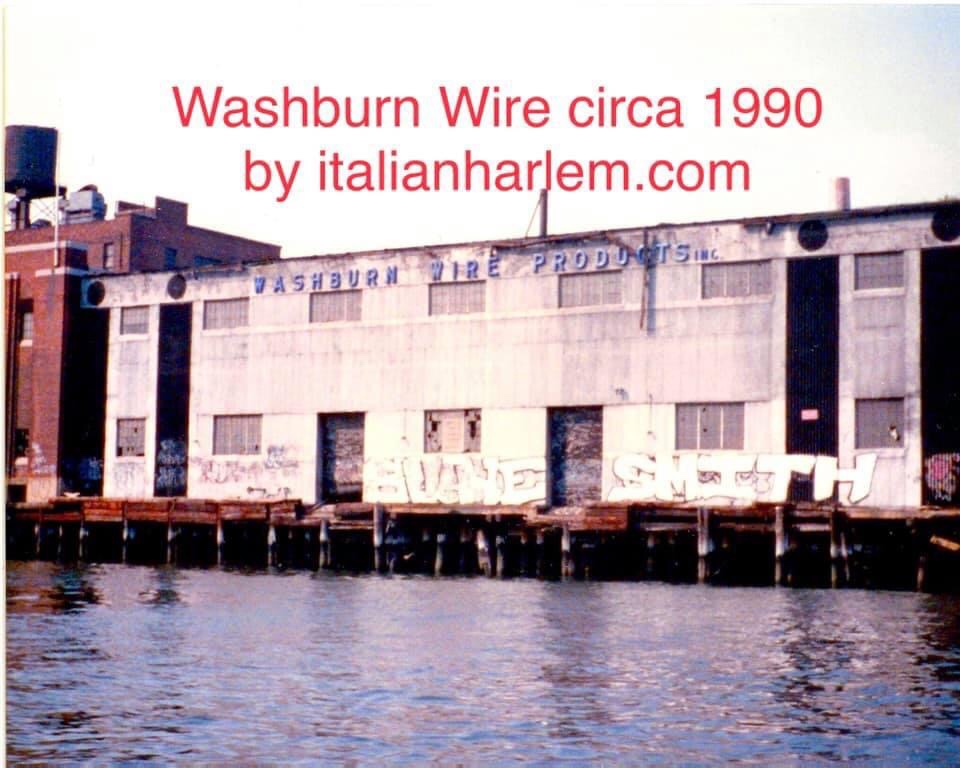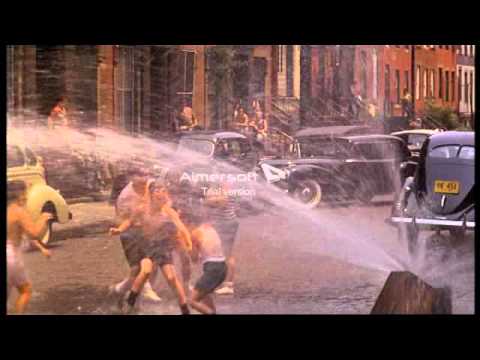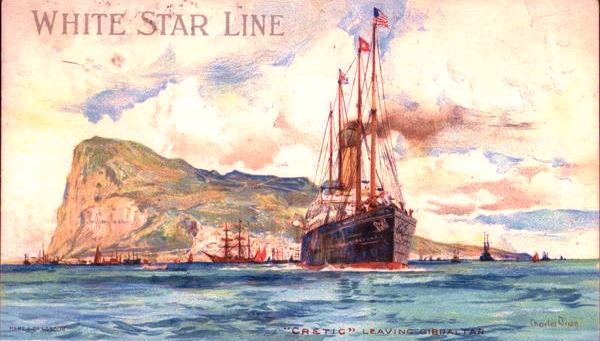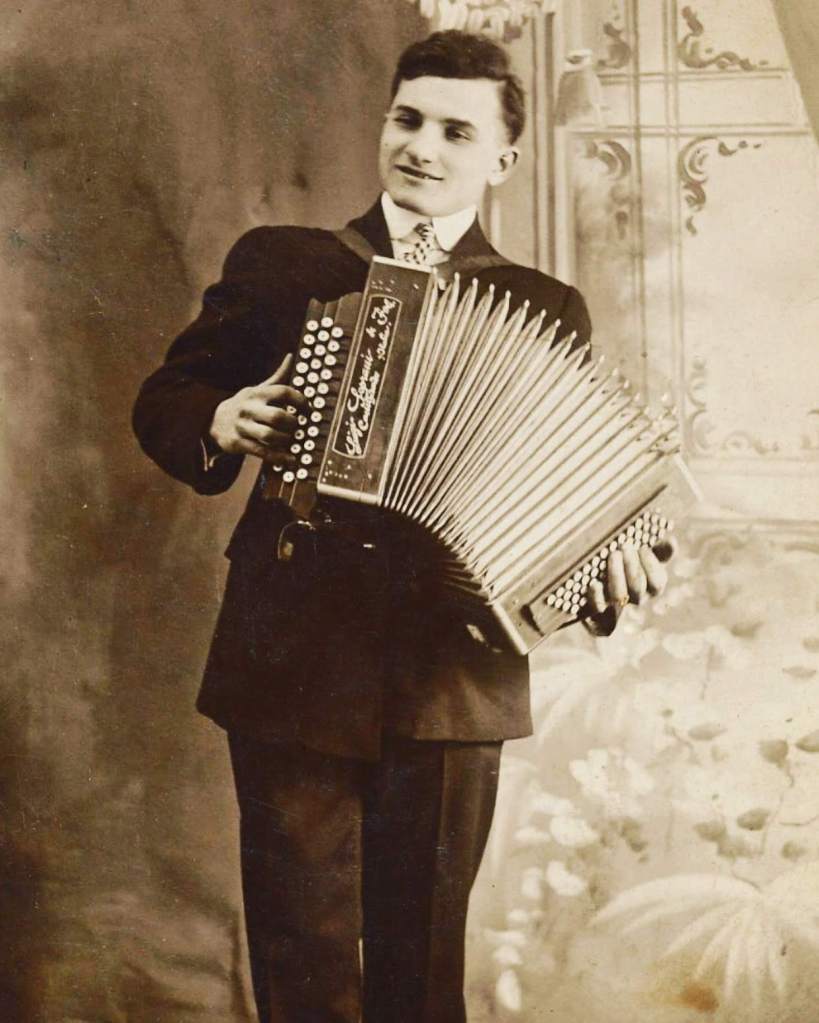MY Grandfather, ANTIMO, was a true Neapolitan!
Posted: June 16, 2022 Filed under: East Harlem, Immigration history, Italian Americans, Italian East Harlem, NEW YORK ITALIANS | Tags: Italian Immigrants, Naples, New York City 9 CommentsMany years ago, while interviewing my cousin Herby for family recollections, he had mentioned that our grandfather, Antimo (nicknamed “Tony”) operated a produce store, around the corner from Arthur Avenue (across from St.Barnabus Hospital.) *Note: The timeline for this story is around the mid to late 1950’s.* Herby clearly recalled the fact that, written on the storefront awning, were the words, “Tony’s Live and Let Live…” Hence, Tony’s favorite quote was, “Live and Let Live! Ha ha!
Antimo Puca was the second child born to Stefano Puca and Teresina Milo. He was born in the small town of Sant’Antimo, Naples, on the 25th day of August, 1896. The first child born to his parents was a boy named Antimo. He was named in the traditional fashion, to honor Stefano’s father, Antimo Puca. Tragically, this baby died. Perhaps he died from the Cholera epidemic which was running rampant across Italy, at that time. Hence, when their second baby arrived , he was also named Antimo!
Antimo’s parents, Stefano and Teresa, were married in Sant’Antimo on the 25th day of November, 1892. Teresa was 23 and Stefano was 21. According to our family history lore, Teresa was supposed to marry Stefano’s older brother, Filippo, but he tragically died, in 1891, while serving in the army. (I found his death record.) Stefano stepped up to the plate and married his older brother’s fiance, out of respect for his brother, and poor Teresina. (Those were the old Italian customs, I guess!)
Later on, in September of 1901, Stefano made the decision to travel to America in search of a better way to support his family. He traveled, in steerage, on the S.S. Burgundia, from the Fabre Line’s fleet of steamships. Upon arrival at Ellis Island’s immigration processing station, he passed through and went to East Harlem to live with his cousin, on Lexington Avenue. Stefano went back to Italy, and in 1905, he was back in New York, having traveled in “steerage” on Fabre Line’s S.S.Germania.
At that time, Stefano was living at 2123 1st Avenue in E.Harlem. The 3-story “old law tenement” was located between E.109th and 110th Streets.
Today, the building is no longer there, however, the adjacent tenements still stand. They are relics of the past. Mementos of a time, long gone. These surviving tenements are the final vestiges of the mass exodus from Europe. They were built for the purpose of housing multitudes of immigrant laborers.
Whenever I visit East Harlem, I feel, in my heart, what my family before me felt. Standing on the very sidewalks that they had stepped upon, looking at the tenements that they once dwelled in, helps me to understand what sacrifice they endured. Being in their old environs, I’m able to envision their arrival from Naples. You might think that it was a joyous arrival, but it was more bittersweet and complicated than celebratory. I think about the utter emptiness that they must have felt, when they stepped into those dark and musty tenement hallways…The despair that they possessed within, wondering if they made the right choice to leave the only home that they ever knew. At the turn of the century, New York City was a far cry from the town of Sant’Antimo, and the City of Benevento, Italy. The fresh Italian air, the open fields, friendly familiar faces, were all a shadow of the past. (Antimo would live to the age of 82, without ever seeing Italy again.)
The new reality for people like Stefano Puca would be hard labor, sacrifice and the burning hope and desire for a new and better life. They would work around the clock, only to earn about 10 dollars a week. But this would be enough to pay their rent, buy their food, and send money back to their families abroad.
Within 4 years time, the Puca’s would reunite, and settle in East Harlem. Stefano would come back to New York in April, and Teresina and her 6 year old daughter, Rosina, would arrive on the 3rd of July. Antimo’s name was crossed out from the ship manifest. He did not travel with his mother and sister. Perhaps he was sick and the shipping line, “White Star Line,” refused his entrance onto the “S.S. Romanic.” Perhaps he was reluctant to go to America. He was only 8 1/2 yrs. old at that time, and he may have been rebellious to the idea of leaving his home. Who would blame him?
At any rate, what I do know is that, on the 28th day of March, 1906, 9 days before Mt.Vesuvius in Naples would erupt, Antimo Puca arrived at Ellis Island, having traveled 13 grueling days in steerage, on the S.S. Cretic. He was accompanied by his uncle, and they were detained on Ellis Island for 2 days, until Stefano signed as surety for them. Written on their Detention list were the letters “LPC.” That stood for the words, “Likely Public Charge.” Until they could prove that they would not be a “financial burden” on the United States, they would be held in detention, on Ellis Island. Luckily, their detention was short. Most likely, they sent a Western Union wire to Stefano, explaining that he must come to Ellis Island to sign for their release. Of course, Stefano came to pick them up…And that is the story of the Puca’s and their journey from Naples to New York!
‘‘Twas a balmy summer day on the East River…Look, there’s Washburn!
Posted: November 8, 2021 Filed under: Angela's picture galleries, Architecture, But Not Forgotten!, East Harlem, Gone, Italian Americans, Italian East Harlem, New York City, NEW YORK ITALIANS, Pleasant Avenue, Vintage Photography | Tags: East Harlem, East River, factory, forgotten new york city, Gone, History, Italian American, Italian East Harlemites, Italian Harlem, Italian Immigrants, Journey to Italian Harlem, Little Italy, Manhattan, New York City, Nostalgia, nyc, old building, Pleasant Avenue, Urban History, urban landscape, vacant, vintage photographs, Washburn Wire 8 CommentsOn a warm summer day, well over 30 years ago, I was out boating with my cousin, Guy. As we were passing East Harlem, heading North up the East River, I saw the vacant Washburn Wire Factory. It was located between East 117th and 118th Street, at the end of the 500 block, off Pleasant Avenue, by the East River Drive.
My family lived right up the block from that once active factory- back in the 1950’s and ‘60’s. At the time of this actual photo, I had a feeling that Washburn had outlived its welcome, and that it would be just a “matter of time” before it would be (ultimately) demolished & replaced. So…with that thought in mind, as we were drawing closer to the vacant factory, I quickly reached for my film camera and took this photo!
Behold a moment in time- captured on a hazy & humid summer day- on the often tumultuous East River! Thankfully, the river was very calm when this photo was taken!
AIEH

VINTAGE EAST HARLEM- FLASHBACK to P.S. 102: FIRST GRADE CLASS PHOTO!
Posted: November 6, 2021 Filed under: Angela's picture galleries, East Harlem, East Harlem School Days, Italian Americans, Italian East Harlem, Just for fun, New York City, NEW YORK ITALIANS, Vintage Photography | Tags: East Harlem, first generation italian american, History, Italian, Italian American, Italian Harlem, italians, Little Italy, memory lane, New York City, nyc, nyc public schools, public school 102, school days, second generation italian american, Tenements, the old neighborhood, uptown little italy 11 CommentsThis heartwarming “blast from the old neighborhood’s past”, was thoughtfully sent to me by one of my readers, Steven B., who is a former Italian East Harlemite. This adorable photo depicts Steven’s 1st grade class, from Public School #102, which is located at 315 East 113th Street-between 1st & 2nd Avenue. The approximate year was circa 1953-54.
According to Steven’s memories of his East Harlem school days, the male teacher in the photo was named Mr. Dupoid. (spelling uncertain). You can find Steven sitting in the first row-4th from the right, with hat in hand. 🙂 Thank you so very much for sharing this wonderful vintage photo with us, Steven! It truly is a historical gem!
A note to my readership: Take a look at the teachers, and the children in this class photo. If you recognize anyone, feel free to comment on who they are, and point out exactly where they are in this photo! Thanks, and enjoy! P.S. The children in this photo would currently be around 73-74 years old!

Antonino Carroccio: A Day in the Life
Posted: February 3, 2018 Filed under: Angela's picture galleries, digital photography, East Harlem, Italian East Harlem, NEW YORK ITALIANS, Tenements, Vintage Photography | Tags: carroccio, cheese shop, History, Italian, Manhattan, New York City, Nostalgia, nyc, shops of italian harlem, vintage east harlem 3 Comments About a month and a half ago, I checked my email inbox, and found this wonderful vintage photo. It made my day! Grazie mille, Paolo!
About a month and a half ago, I checked my email inbox, and found this wonderful vintage photo. It made my day! Grazie mille, Paolo!
The man standing near the doorway is Antonino Carroccio. He is the paternal grandfather of Paul Carroccio, who was kind enough to share this fabulous vintage photo, circa 1928. The man sitting in the truck, was Morris Croot, a farmer from Holland Township, New Jersey.
Antonino was part owner of a family-run cheese shop, “Latticini” located at 311 East 107th St., N.Y.C. His father, Alfio Carroccio, came to America in 1890, and settled in a tenement building at 311 E. 107th Street. Subsequently, Alfio opened this latticini/cheese shop, selling mozzarella, ricotta, eggs, butter, milk, etc. After establishing this business in East Harlem’s Italian quarter, Alfio returned to Sicily around 1904, and left the business to his sons, Antonino, and Alfio, Jr.
Paul mentioned in his email to me, that the cheese was originally made locally in East Harlem, but the milk they bought to make the cheese, came from New Jersey. However, the family continued to do that until 1908, when they decided to rent a location in New Jersey (to make the cheese) nearby to where they bought the milk, for freshness sake. So began the shipping of cheese (in ice) to East Harlem! The cheese from the Carroccio’s Latticini shop was sold to local residents, Rao’s restaurant, on Pleasant Avenue, and many other establishments. Hey, come to think of it, I bet that my grandparents, and great-grandparents bought cheese and other items from this cheese shop! If only I could ask them! AIEH…thanks for the memories!
My Motivation Behind the Creation of ItalianHarlem.com- My Father, Albert :-)
Posted: October 27, 2015 Filed under: Angela's picture galleries, But Not Forgotten!, East Harlem, Genealogy & DNA, Italian Americans, Italian East Harlem, Vintage Photography, Voices of East Harlem | Tags: 1800's, 1900's, Blogging, Digital Memorial, East Harlem, Family, Family History, Harlem, Historical, History, Immigrants, Italian, Italian American, Italian East Harlem, Italian Harlem, Italian Immigrants, Little Italy, Manhattan, Memory, Motivation, New York City, Nostalgia, nyc, Tenement, Tenement Life, Tenements, Turn of the Century, Urban History, Urban Jungle 10 Comments In December of 2007, I was 3 years into my “whirling dervish” obsession of gaining every drop of family history knowledge that I could garner. It became self-evident that my ancestral journey had begun, and so I conceived the idea of creating a website to memorialize, and forever “etch” into existence, the information that I would render from this extensive research. I named my website “Pathway to My Ancestry,” and so began the painstaking steps to build the site on the then existing “Live Spaces” platform. A few years into building the site, live spaces was drawing to closure, thereby necessitating me to find another platform to maintain my website. Hence, I found WordPress, and so here I am, and hopefully, will continue to be! In the interim, I had to transfer whatever was transferable to the new website, and decided to change the title of my blog to “Italian Harlem.”
In December of 2007, I was 3 years into my “whirling dervish” obsession of gaining every drop of family history knowledge that I could garner. It became self-evident that my ancestral journey had begun, and so I conceived the idea of creating a website to memorialize, and forever “etch” into existence, the information that I would render from this extensive research. I named my website “Pathway to My Ancestry,” and so began the painstaking steps to build the site on the then existing “Live Spaces” platform. A few years into building the site, live spaces was drawing to closure, thereby necessitating me to find another platform to maintain my website. Hence, I found WordPress, and so here I am, and hopefully, will continue to be! In the interim, I had to transfer whatever was transferable to the new website, and decided to change the title of my blog to “Italian Harlem.”
Consequently, my ancestral journey transitioned from a personal family history journey, to a much broader sense of consciousness…that of the desire for public awareness of a now defunct Italian community in New York City. This “microcosm” of an urban neighborhood was “developed” in the 1870’s, with the building of tenement housing, and was originally inhabited by Italian immigrants, primarily male laborers. I discovered a broader sense of the “pulse” of this Italian community, through the voices of my father, his brothers, sisters, cousins, and others who once lived in East Harlem, when it was referred to by its residents as “Harlem.” As I listened to the stories of a bygone time, resounding with carefree thoughts of the “good old days,” it occurred to me that there was much more to this old neighborhood than the stories that were resonating in my mind. I was right! The posts that I have shared, and will share, within this blog, are a testament to the true nature, and fabric of a place that really mattered to a multitude of Italian immigrants and their families.
As I am drawing near to the 11th year anniversary of what has become a nostalgic endeavor of “genealogical/anthropological/sociological/historical” research of “Ye Olde Italian Harlem,” I must tell you that this historical journey has been, and will continue to be an intrinsic part of my life here on this planet. My interest in preserving the memory of Italian Harlem will never falter. My research is a true passion of mine, one of many passions that I am fortunate enough to have in my life, including first, and foremost, my beautiful children, a loving and devoted husband, and my adorable rescue Shih Tzu furbaby “Romeo.” I also embrace my love of photography, and my fascination for the metaphysical sciences!
If there was one person that instilled in me an interest in the history of Italian Harlem, it was my father. My dad was born in 1924 in a tenement apartment on East 110th Street, right next to St. Ann’s Church. He was one of 7 children. His dad, Anthony (Tony) was a produce shop owner, who also sold fruits and vegetables on a pushcart on First Avenue. My dad’s mom, Catherine (Katie) was a seamstress, church secretary, playwright/producer, milliner,(hatmaker) homemaker, realtor, entrepreneur…a true Renaissance woman. I learned so much about my grandparents, and great grandparents, thanks to the amazing memory of my father, Albert, and his siblings. I am forever grateful to them for sharing with me, through their youthful eyes, their life and times in the old neighborhood.
My father, who was “larger than life,” passed away 3 days before his 89th birthday, in January of 2013. I dedicate this website to the memory of my wonderful and charismatic father, who was known by many as “Uncle Al.” Although he had hoped to live to “a hun 10,” (as he would often say,) his bright spirit and memory lives on throughout this weblog and within the lives of those who knew, and very much loved him.
An East Harlem Scene from “The Godfather”: Sonny Corleone(James Caan) beats up his brother-in-law Carlo(Gianni Russo.)
Posted: July 6, 2013 Filed under: East Harlem, FYI, Italian East Harlem, Movies Filmed in East Harlem, New York City, Pleasant Avenue, Tenements | Tags: ahun 18th Street, East 118th Street, East Harlem, New York City, The Godfather Movie 7 CommentsThe Godfather Movie:Click on this link to view YouTube video- Sonny Corleone(James Caan) beats up his brother-in-law Carlo(Gianni Russo.)
In this scene from The Godfather, James Caan seeks revenge for the unmerciful beating of his pregnant sister, Connie Rizzi. He heads for East Harlem’s E. 118th Street, to brutally beat up his wife-beating brother-in-law Carlo Rizzi(played by Gianni Russo.)
The scene was filmed on the 500 block of East 118th Street. My family and I lived there before this movie was filmed. The stoop that Carlo(wearing an orange and tan suit) is standing on-before he attempts to run from crazed Sonny, is 503 East 118th Street.
Note of Trivia: Most of the principal photography took place from March 29, 1971 to August 6, 1971, although a scene with Pacino and Keaton was shot in the autumn. There were a total of 77 days of shooting, fewer than the 83 for which the production had budgeted. (https://en.wikipedia.org/wiki/The_Godfather#Production)
This particular scene was filmed in the summer of 1971.(My educated guess, based on the filming timeline, and the fact that the children are being soaked by the “johnny pump.”) 


Tenement Interior- Circa 1900-1910
Posted: June 19, 2013 Filed under: digital photography, Vintage Photography | Tags: New York City, Tenement Leave a commentPublisher: Detroit Publishing Company. From the Library of Congress digital archives.
http://www.loc.gov/pictures/item/det1994001696/PP/
West Side Story – Prologue
Posted: March 28, 2011 Filed under: Music, New York City | Tags: East Harlem, Italian Harlem, New York City, Tenements, video, West Side Story, YouTube Leave a commentVodpod videos no longer available.
I know…what does this have to do with East Harlem? Hey, it’s Freedomland! Need I say more?
Posted: March 8, 2011 Filed under: New York City | Tags: Bronx, Co-Op City, Freedomland, freedomland usa, New York City Leave a commentI couldn’t resist posting this archived video of the short-lived “Freedomland Amusement Park,” once located in Co-op City, Bronx, New York. (1960-1964.) Click on the link below to view the video stream.





Recent Comments